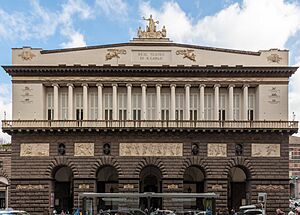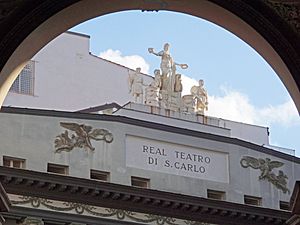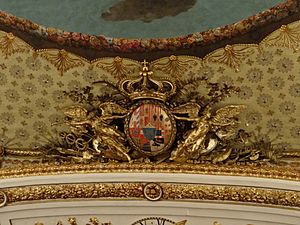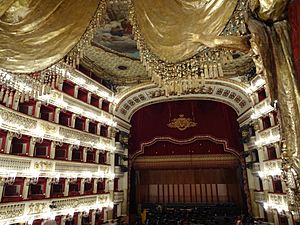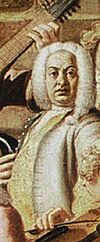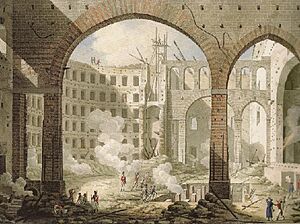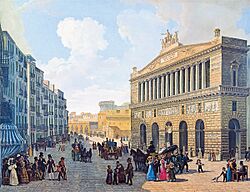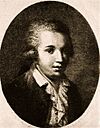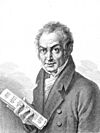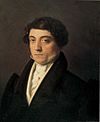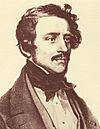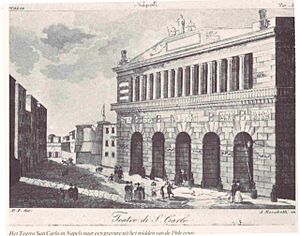Teatro di San Carlo facts for kids
The Real Teatro di San Carlo, which means "Royal Theatre of Saint Charles," is a famous opera house in Naples, Italy. It is often called the Teatro di San Carlo. The theater is located right next to the Royal Palace of Naples.
It is the oldest opera house in the world that has been running without stopping. It first opened its doors in 1737. This was many years before other famous Italian opera houses like Milan's La Scala or Venice's La Fenice were built.
The opera season at San Carlo goes from late November to July. The theater used to hold over 3,000 people, but now it has 1,386 seats to make it more comfortable. Because of its grand design and old age, it became a model for many other theaters built across Europe.
Contents
History of the Opera House
The Teatro di San Carlo was ordered to be built by King Charles VII of Naples. The king wanted Naples to have a big, beautiful new theater. The old one, called Teatro San Bartolomeo, was built in 1621 and had become too small and worn out.
The new theater opened on November 4, 1737. This date was chosen because it was the king's name day (a day celebrating the saint a person is named after). The first performance was the opera Achille in Sciro by Domenico Sarro. In early operas, it was common for women to play male roles. The part of the hero Achilles was played by a woman named Vittoria Tesi.
In the late 1700s, famous composers came to Naples to work at the San Carlo. Christoph Willibald Gluck directed his opera Clemenza di Tito in 1752. Johann Christian Bach also presented two of his operas there in the 1760s.
Building a Grand Theater in 1737
The theater was designed by the royal architect, Giovanni Antonio Medrano. The inside of the theater is shaped like a horseshoe, which was a new idea at the time. It is the oldest auditorium of this shape in the world.
The hall was large, with 184 boxes for guests arranged in six levels. There was also a special royal box for the king and his family. In total, the theater could hold over 3,000 people, including those who were standing.
The theater was admired for its amazing architecture, gold decorations, and beautiful blue furniture. Blue and gold were the official colors of the Bourbon royal family. At the time, it was the biggest opera house in the world. The design of the boxes had no curtains, so the king could see everyone in the audience from his private box.
Fire and Rebuilding
On February 13, 1816, a fire broke out during a practice for a ballet. The fire spread very quickly and destroyed parts of the beautiful opera house.
King Ferdinand IV, another Bourbon king, ordered that the theater be rebuilt immediately. An architect named Antonio Niccolini was put in charge. In just ten months, the opera house was rebuilt. It reopened on January 12, 1817.
The new design was still a horseshoe shape with 1,444 seats. Niccolini added a famous painting to the ceiling. It shows the Greek god Apollo presenting the world's greatest poets to the goddess Minerva. A famous writer named Stendhal, who was there on the second night, wrote that there was nothing in Europe like it and that it "dazzles the eyes, it enraptures the soul."
In 1844, the theater was decorated again. This is when the inside was changed to the red and gold colors that are still seen today.
Later Changes and Repairs
Over the years, the theater had a few more updates. In 1872, the famous composer Verdi suggested adding an orchestra pit, which is the area in front of the stage where the musicians sit. Electricity was installed in 1890.
During World War II, the building was damaged by bombs. After Naples was freed in October 1943, an officer from the British Royal Artillery named Peter Francis organized repairs. The theater reopened just three weeks later with a musical show. The first opera, La bohème, was performed on December 26, 1943.
By the 2000s, the opera house was old and needed major work. From 2008 to 2009, it was renovated to restore its beauty and update its stage equipment. The theater reopened on January 27, 2010, looking as it did after it was rebuilt in 1817.
The Golden Age of Naples Opera
During the 18th and 19th centuries, Naples was a major center for music in Europe. Composers from the Neapolitan School of opera were famous everywhere. They wrote both serious operas (opera seria) and funny operas (opera buffa). Some of these composers were Leo, Cimarosa, and Paisiello.
Having an opera performed at the San Carlo was a huge honor for any composer. Even composers from other countries, like Haydn and Gluck, came to Naples.
The most famous singers of the day also performed at the San Carlo. This included the famous male singers with very high, powerful voices. Some of the most well-known were Farinelli and Caffarelli.
Famous Composers at San Carlo
From 1815 to 1822, the great composer Gioachino Rossini was the artistic director of the San Carlo. He wrote ten operas for the theater, including Otello and La donna del lago.
After Rossini left, Gaetano Donizetti took his place. He worked in Naples from 1822 to 1838 and wrote 16 operas for the San Carlo. His most famous work, Lucia di Lammermoor, was first performed here in 1835.
Giuseppe Verdi also had a strong connection to the theater. He wrote three operas for the San Carlo: Alzira, Luisa Miller, and another that was later renamed Un ballo in maschera and performed in Rome.
Later Years
When Italy became one country in 1861, Naples was no longer the capital of its own kingdom. Power and money moved to other cities like Milan, and the San Carlo became less important. For a while, the theater even had to close in 1874 because it was not making enough money.
However, the theater's fortunes improved thanks to the support of composers like Giacomo Puccini. In the late 19th century, the theater created its own orchestra. This attracted famous conductors like Arturo Toscanini and Richard Strauss, who brought new types of music to the San Carlo.
One famous singer who refused to return to the San Carlo was Enrico Caruso. He was born in Naples, but after an audience booed him during a performance in 1901, he vowed never to sing there again.
Conductors
The Teatro di San Carlo has had many famous conductors lead its orchestra.
Principal conductors
- Elio Boncompagni (1979–1982)
- Salvatore Accardo (1993–1995)
- Gabriele Ferro (1999–2004)
- Gary Bertini (2004–2005)
- Jeffrey Tate (2005–2010)
- Nicola Luisotti (2012–2014)
- Juraj Valčuha (2016–2022)
- Dan Ettinger (2023–present)
Principal guest conductor
- Maurizio Benini (2010–2011)
Honorary conductor
- Zubin Mehta (2016–present)
See also
 In Spanish: Teatro di San Carlo para niños
In Spanish: Teatro di San Carlo para niños
- Music of Naples
Images for kids


